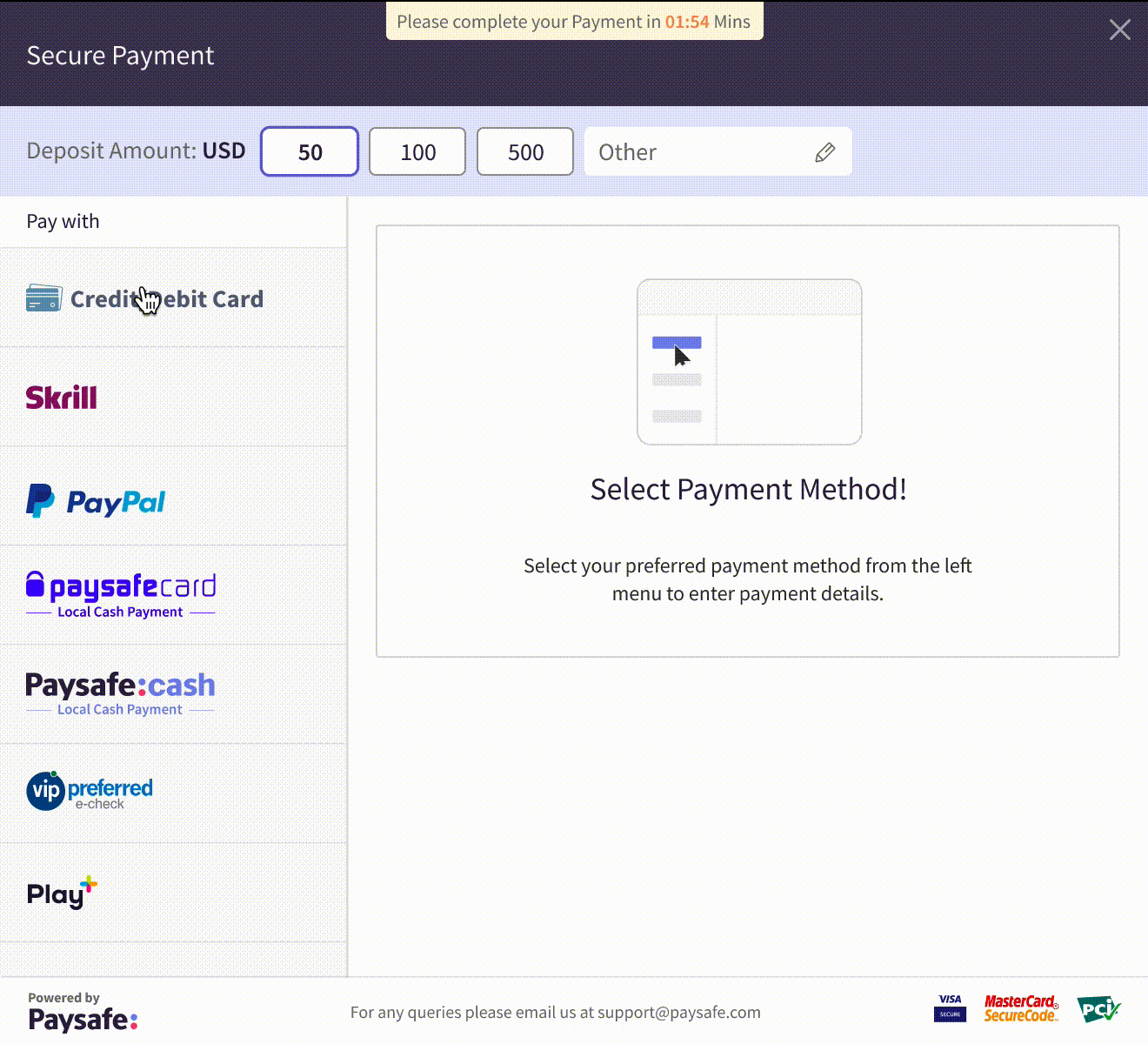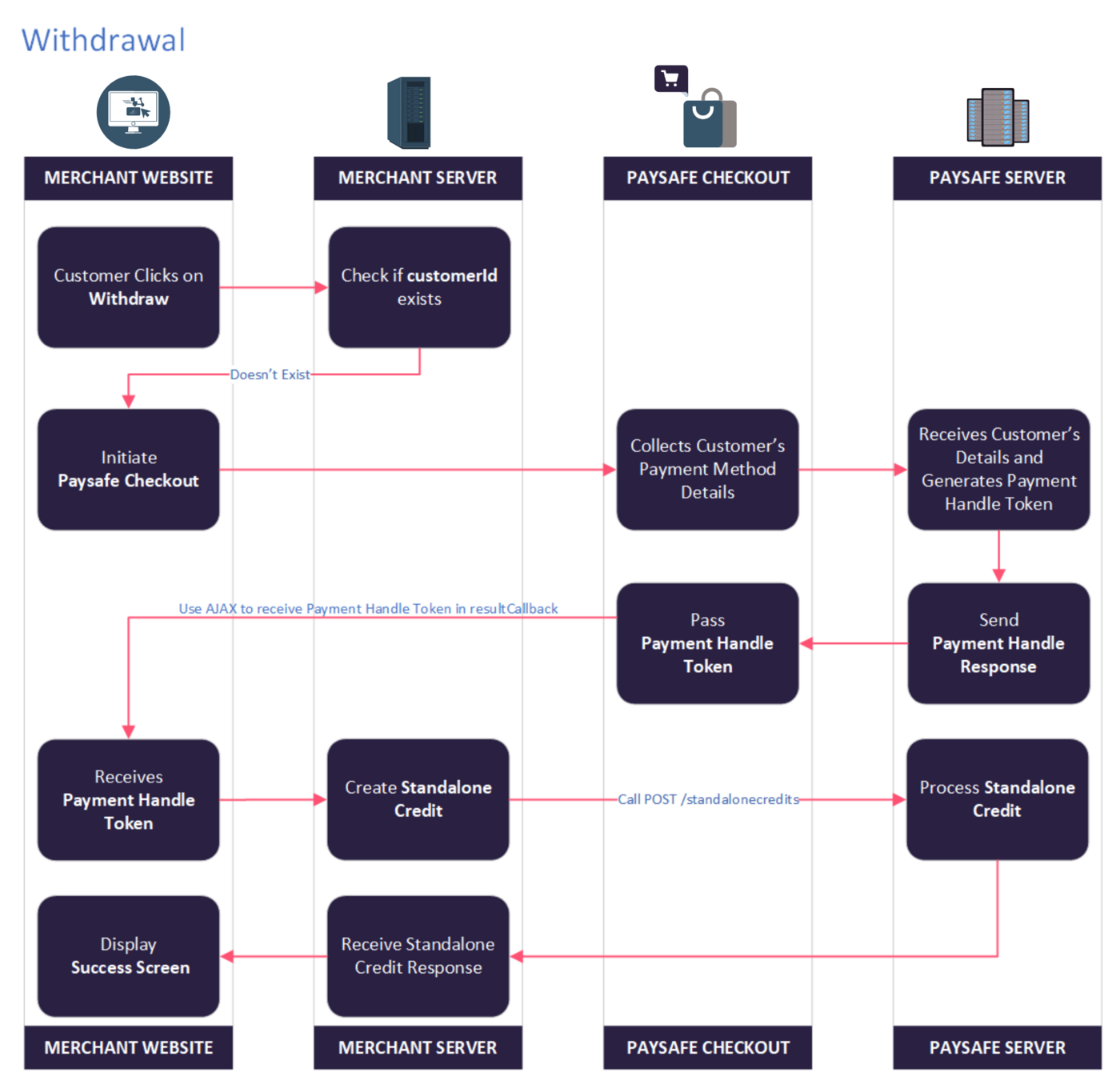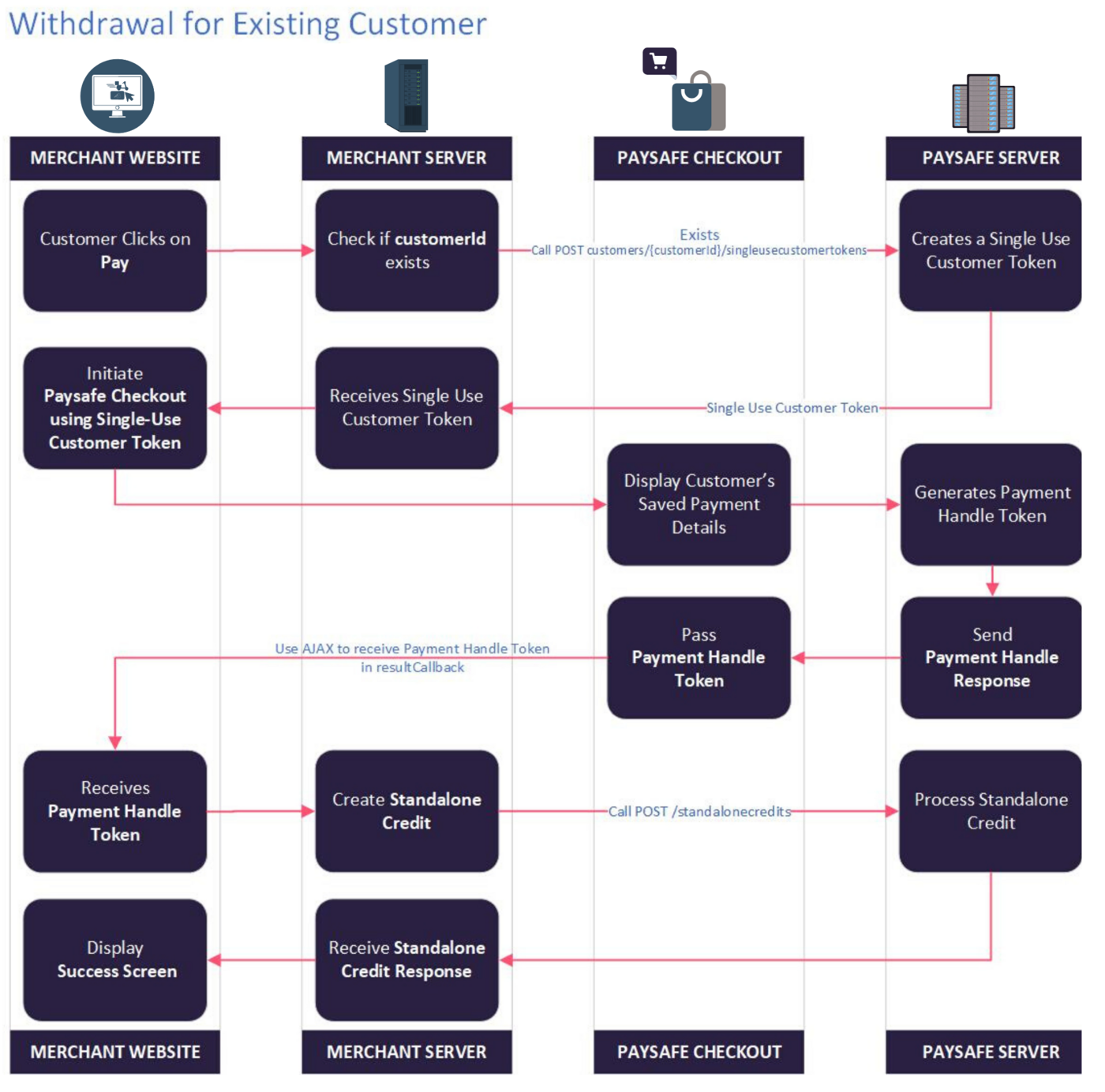Process Withdrawals
Paysafe Checkout enables you to send money back to your customers’ Cards, Bank accounts or Wallets.

-
The Customer initiates the withdrawal.
-
Merchant Server checks if the customer profile is already created at Paysafe.
-
The merchant website initiates the Checkout with setup options.
-
Paysafe Checkout collects Customer’s payment method details.
-
Paysafe server receives the customer details and sends the Payment Handle Response to the Paysafe Checkout.
-
Paysafe Checkout sends the Payment Handle Token to Merchant Website as a part of resultCallback.
-
Merchant website sends the Payment Handle Token to the Merchant server.
-
Merchant server calls the Standalone Credit API using the private key. You must initiate a POST request to the endpoint:
POST/paymenthub/v1/standalonecredits
-
Standalone Credit API processes the request and returns the response.
-
Merchant Server processes the Standalone Credit Response.
-
Merchant Website displays Success screen on the Merchant website.
Here is a typical Scenario for an existing customer making a card withdrawal:
-
The Customer initiates the withdrawal.
-
Merchant Server checks if the customer profile is already created at Paysafe.
-
If the customerId exists, the merchant server makes an API call to create a single-use customer token API using the customerId.
-
The Paysafe server generates and sends the single-use customer token to Merchant Website.
-
Merchant Website initiates the Paysafe Checkout using the single-use customer token.
-
Paysafe Checkout displays the Customer’s saved payment details.
-
Paysafe server generates and sends the Payment Handle Response to the Paysafe Checkout.
-
Paysafe Checkout sends the Payment Handle Token to Merchant Website as a part of resultCallback.
-
Merchant website sends the Payment Handle Token to the Merchant server.
-
Merchant server calls the Standalone Credit API using the private key. You must initiate a POST request to the endpoint:
POST/paymenthub/v1/standalonecredits
-
Standalone Credit API processes the request and send the Standalone Credit Response.
-
Merchant Server processes the Standalone Credit Response.
-
Merchant Website displays Success screen on the Merchant website.
The following code sample shows a minimal Paysafe Checkout example that creates a payment overlay for the user. The overlay contains a Payment button that creates a payment handle for the data entered by the user and displays the payment handle token (if successful) in the browser console.
Paysafe Checkout Code Sample
<!DOCTYPE html>
<!-- Sample Paysafe Checkout Code https://developer.paysafe.com
Please feel free to copy this code to a fresh HTML file, and run it on your device (all desktop and mobile devices are supported).
You may even use this code as baseline to integrate your website with Paysafe & start receiving online payments. -->
<html>
<head>Paysafe Checkout Demo
</head>
<body>
<button onclick="checkout()"> Paysafe Checkout </button>
</body>
<script src="https://hosted.paysafe.com/checkout/v2/paysafe.checkout.min.js"></script>
<script type="text/javascript">
var API_KEY_MERCHANT_TEST = "<Please-Insert-Your-Base64-Encoded-API-Key-Here>";
function checkout() {
paysafe.checkout.setup( API_KEY_MERCHANT_TEST, {
currency: "USD", // 4 currencies currently supported by Paysafe Checkout - "USD", "CAD", "EUR", "GBP"
amount: 10000, // This qualifies as USD $ 100.00. Multiply Payment Amount by 100 and supply here.
payout: true, // payout: true --> for Withdrawal (standalone credits); payout: false --> for Payments/Deposit
payoutConfig: { // payoutConfig section required only when payout: true [for Withdrawal cases].
"maximumAmount": 100000000
},
locale: "en_US",
simulator: "EXTERNAL",
imageUrl: "https://hosted.paysafe.com/checkout/resource/demo-store/images/logo.png", // Supply Your Logo URL here.
environment: "TEST", // environment: "LIVE" --> Production, "TEST" --> test environment for customers to try out Checkout & its features
buttonColor: "#66cc99", // feel free to change the color of buttons (RGB value)
companyName: "Example Paysafe Merchant", // Supply Your Company Name here
holderName: "John Smith", // Supply Customer's Name here
customer: {
firstName: "John",
lastName: "Dee",
email: "johndee@paysafe.com",
phone: "1234567890",
dateOfBirth: { // dateOfBirth : This {section} is optional, needs to be provided only if you want to prefill DOB in Checkout.
day: 1, // If dateOfBirth : {section} is not supplied, Checkout will allow the customer to enter his DOB before Payment.
month: 7,
year: 1990
}
},
billingAddress: { // Supply customer's billing Address here.
nickName: "John Dee",
street: "20735 Stevens Creek Blvd",
street2: "Montessori",
city: "Cupertino",
zip: "95014",
country: "US",
state: "CA"
},
merchantRefNum: "Supply Merchant Ref Num Here. (Unique For Every Transaction)", // Will be unique and must keep changing every transaction
canEditAmount: true, // Makes the payment amount editable on Checkout screen. Make it false to open Checkout with a fixed non-editable amount.
merchantDescriptor: {
dynamicDescriptor: "XYZ",
phone: "1234567890"
},
displayPaymentMethods: ["neteller", "skrill", "paysafecard", "paysafecash", "instantach", "paypal", "card", "vippreferred", "sightline", "ach", "eft"],
// displayPaymentMethods : Array serves two purposes. You can use it to restrict the payment methods that a customer can see.
// You can also use it to order the payment methods based on your preference.
// If this field is present, the customer will only see those payment methods in the order specified, hence,
// Ensure that you provide all payment methods if you are using it only for the purpose of payment method ordering.
paymentMethodDetails: { // Please read the Checkout Objects Documentation on developer.paysafe.com .....
paysafecard: { // .... for details on paymentMethodDetails (including all supported mandatory and optional fields)
consumerId: "123456"
},
paysafecash: {
consumerId: "123456"
},
sightline: {
consumerId: "12341231256",
SSN: "123456789",
last4ssn: "6789",
//accountId: "1009688222" // Supply Account ID only if multiple accounts are configured with same payment method
},
vippreferred:{
consumerId: "120288765",
//accountId: "1679688456" // Supply Account ID only if multiple accounts are configured with same payment method
},
card: {
//accountId: "1009688230" // Supply Account ID only if multiple accounts are configured with same payment method
},
skrill: {
consumerId: "greg_neteller@mailinator.com",
emailSubject: "Payout for Greg Neteller",
emailMessage: "You Have Received Payout of $100."
},
instantach: {
consumerId: 'john.doe@email.com',
paymentId: '3aeb9c63-6386-46a3-9f8e-f452e722228a',
emailSubject: 'Instant ACH Payout',
emailMessage: 'Your Instant ACH Payout request has been processed'
},
neteller: {
consumerId: "netellertest_EUR@neteller.com",
recipientDescription: "logo_url_alt_text",
logoUrl: "http://www.paysafe.com/icon.jpg"
}
}
}, function (instance, error, result) {
if (result) {
alert(JSON.stringify(result, null, 4));
} else {
alert(error);
}
if (result.token) {
alert("Payment Token (Returned By Paysafe GW): " + result.token);
if (result.paymentMethod == "Cards") {}
if (result.paymentMethod == "DirectDebit") {}
if (result.paymentMethod == "Interac") {}
}
}, function (stage, expired) {
alert ("Payment Handle Stage :: " + stage);
switch (stage) {
case "PAYMENT_HANDLE_NOT_CREATED": // Handle the scenario
case "PAYMENT_HANDLE_CREATED": // Handle the scenario
case "PAYMENT_HANDLE_REDIRECT": // Handle the scenario
case "PAYMENT_HANDLE_PAYABLE": // Handle the scenario
default: // Handle the scenario
}
});
}
</script>
</html>

